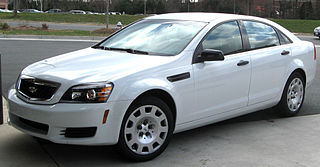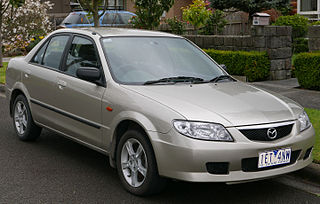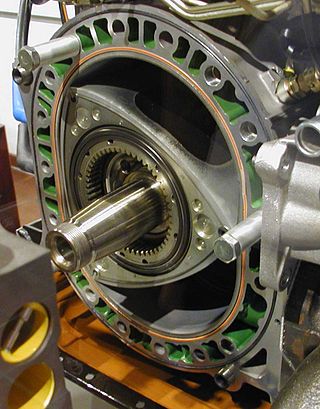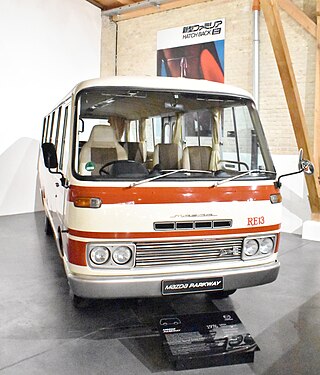
Holden, formerly known as General Motors-Holden, was an Australian subsidiary company of General Motors. Founded in Adelaide, South Australia, it was an automobile manufacturer, importer, and exporter that sold cars under its own marque in Australia. In its last three years, it switched entirely to importing cars. It was headquartered in Port Melbourne, with major industrial operations in the states of South Australia and Victoria. The 164-year-old company ceased trading at the end of 2020.

The Mazda RX-7 is a front-engine, rear-wheel-drive, rotary engine-powered sports car that was manufactured and marketed by Mazda from 1978 until 2002 across three generations, all of which made use of a compact, lightweight Wankel rotary engine.

The Mazda RX-8 is a sports car manufactured by Japanese automobile manufacturer Mazda between 2002 and 2012. It was first shown in 2001 at the North American International Auto Show. It is the direct successor to the RX-7. Like its predecessors in the RX range, it is powered by a rotary Wankel engine. The RX-8 was available for the 2003 model year in most parts of the world.

The Chevrolet Caprice is a full-size car produced by Chevrolet in North America for the 1965 to 1996 model years. Full-size Chevrolet sales peaked in 1965 with over a million sold. It was the most popular car in the U.S. in the 1960s and early 1970s, which, during its lifetime, included the Biscayne, Bel Air, and Impala.

The Mazda Cosmo is an automobile which was produced by Mazda from 1967 until 1995. Throughout its history, the Cosmo served as a "halo" vehicle for Mazda, with the first Cosmo successfully launching the Mazda Wankel engine. The final generation of Cosmo served as Mazda's flagship vehicle in Japan, being sold as the Eunos Cosmo through its luxury Eunos division in Japan.

The Mazda Luce is an executive car that was produced by Mazda in Japan from 1966 until 1991. It was widely exported as the Mazda 929 from 1973 to 1991 as Mazda's largest sedan. Later generations were installed with luxury items and interiors as the Luce became the flagship offering. The Luce was replaced by the Sentia in 1991 which was also exported under the 929 nameplate.

The Mazda Familia, also marketed prominently as the Mazda 323, Mazda Protegé and Mazda Allegro, is a small family car that was manufactured by Mazda between 1963 and 2003. The Familia line was replaced by the Mazda3/Axela for 2004.

The Subaru 360 is a rear-engined, two-door city car manufactured and marketed from 1958 to 1971 by Subaru. As the company's first automobile, production reached 392,000 over its 12-year model run.

The General MotorsJ platform, or J-body, is an automobile platform that was used by General Motors for compact cars from the 1982 to 2005 model years. The third generation of compact cars designed by GM, the J-body marked the introduction of front-wheel drive for its compact model lines, simultaneously replacing the rear-wheel drive H-body and the European U-body platforms, the latter being a stretched version of the original rear-wheel drive T-body. The J-body was marketed as a world car, with GM brands selling versions of the platform in North America, Europe, Australia, and Japan; in markets outside of North America, the model line was packaged as a mid-size car.

The Mazda Wankel engines are a family of Wankel rotary combustion car engines produced by Mazda.

The Mazda Sentia is a mid-size rear wheel drive luxury car that was sold by Mazda in Japan from 1991 to 1999 over two generations. It replaced the Mazda Luce nameplate on the Mazda H platform, and continued the tradition of being Mazda's largest flagship sedan, which had been in production since the late 1960s.

The Holden Kingswood is a full-size car that was developed and manufactured in Australia by Holden, from the beginning of the HK series in 1968 through to the conclusion of the WB series in 1985. Prior to 1968, the full-size Holden range of family cars comprised the Holden Standard, the Holden Special, and Holden Premier models. Initially, the HK range of models included the basic Holden Belmont, the Kingswood, and the luxury-oriented Holden Premier, all of which were manufactured in a choice of sedan and station wagon bodies. Commercial variants were offered in three types: coupé utility, panel van, and later from 1971, a heavy-duty Holden One Tonner cab chassis. The utility (ute) version was originally marketed in both Belmont and Kingswood configurations. However, after the Belmont name was deleted from commercials at the end of HQ in late 1974, the base model commercials were sold only with the "Holden" badge.

The Nissan Cedric is a large automobile produced by Nissan since 1960. It was developed to provide upscale transportation, competing with the Prince Skyline and Gloria which were later merged into the Nissan family. In later years, the Nissan Skyline was positioned as a sports sedan/coupe, whereas the Nissan Gloria was turned into a sporty version of the Cedric.

The DeSoto Firedome was a full-size automobile produced between 1952 and 1959 by the DeSoto division of the Chrysler Corporation. Introduced as DeSoto's premium line of vehicles for the 1952 model year, it retained that position until demoted to the least expensive model for 1955. It was reclassified to become a mid-range vehicle for 1957 and was discontinued for the 1960 model year.

The Isuzu Florian is an intermediate class car manufactured by Isuzu Motors Ltd. in Japan from November 1967 until 1983. The Florian's body remained essentially the same through its unusually long life cycle, being afforded only two moderate facelifts. The Isuzu Florian was originally presented as the Ghia Isuzu 117 Sedan at the 1966 Tokyo Motor Show and shared its complete chassis with the closely related Isuzu 117 Coupé. Originally available only with a 1.6 liter gasoline inline-four engine producing 84 PS (62 kW) at 5200 rpm, a 1.8 liter version was later added as was a diesel option, first seen in 1977.
General Motors New Zealand Limited, is a subsidiary of General Motors that distributes GM' motor vehicles, engines, components and parts in New Zealand.

The 1982 James Hardie 1000 was the 23rd running of the Bathurst 1000 touring car race. It was held on 3 October 1982 at the Mount Panorama Circuit just outside Bathurst in New South Wales, Australia. The race, which was Round 3 of both the 1982 Australian Endurance Championship and the 1982 Australian Endurance Championship of Makes, was open to cars eligible to the locally developed CAMS Group C touring car regulations with two engine capacity based classes.

The Mazda Grand Familia is an automobile which was produced by Mazda in Japan from 1971 to 1978. It was sold as the Mazda 808 in some export markets including Asia, Australia, and New Zealand, and as the Mazda 818 in many others - this was mostly due to Peugeot having trademarked three-digit numbers with a middle zero in many markets. The body style configurations offered were a two-door coupé, a four-door sedan, and a five-door station wagon. The Grand Familia offered only inline four cylinder engines. The largely identical rotary-powered versions were marketed as the Mazda Savanna in Japan, with export markets taking this model as the Mazda RX-3.

Amati was a proposed luxury brand announced by Mazda in August 1991 as part of Mazda's expansion plan with the launch of the Autozam, Eunos, and ɛ̃fini marques in hopes of becoming Japan's 3rd largest automaker. It was scheduled to launch in 1994 as a competitor to fellow Japanese luxury car marques Acura, Infiniti and Lexus as well as American and European luxury vehicles. However, when the Japanese economy collapsed in early 1992 Mazda faced a liquidity shortage and was unable to complete development of the brand. Mazda announced the cancellation of the Amati brand in October 1992 and the completed vehicles were sold under Mazda's existing brand names.

The Mazda Parkway is a minibus that was based on the Mazda Titan platform, and was manufactured at the Hiroshima Factory exclusively for the Japanese market. In 1974, the Parkway was installed with the 13B rotary engine and well as a 2000cc gasoline type "VA" and the diesel 2500cc type "XA". It also offered a novel transmission approach added to the manual transmission installed, called a sub transmission to cope with the load carrying requirements, and a fluid coupling to preventing engine stalling, knocking and oscillation. The rotary-powered minibus was called the Parkway Rotary 26, and could accommodate 26 passengers, even though it weighed 2,835 kg (6,250 lb), and could achieve a maximum speed of 120 km/h (75 mph). It was introduced July 22, 1974 and the rotary engine was replaced with a more conventional diesel engine in 1977.




















